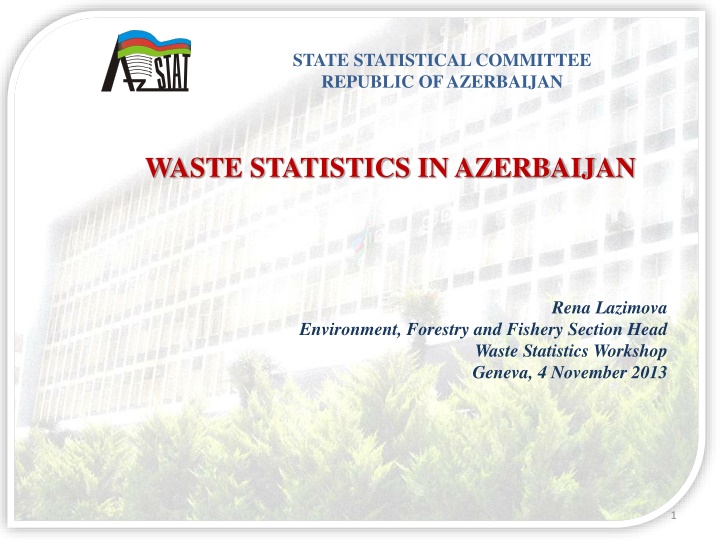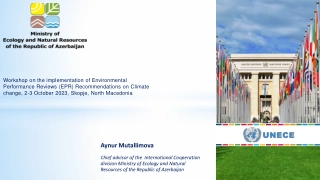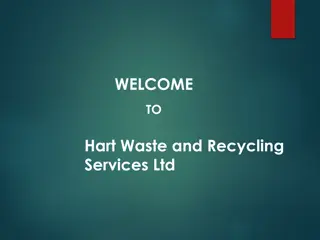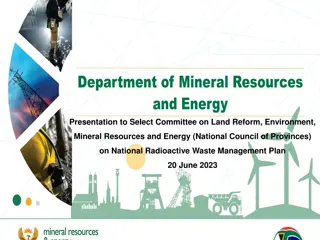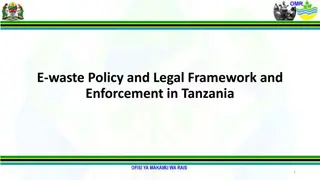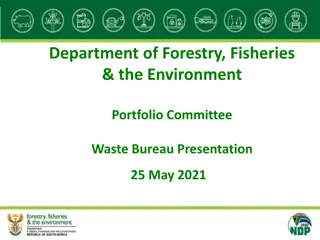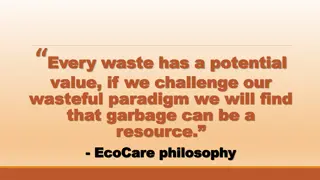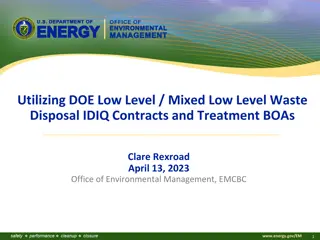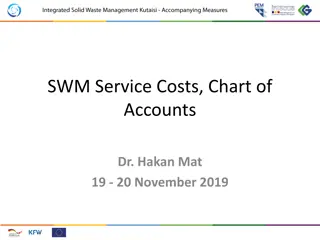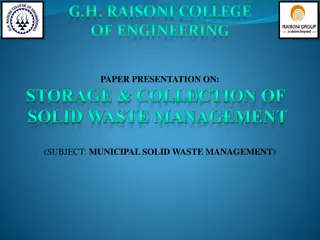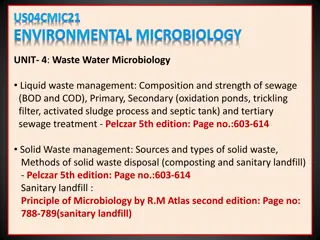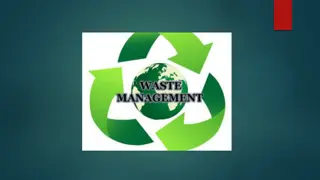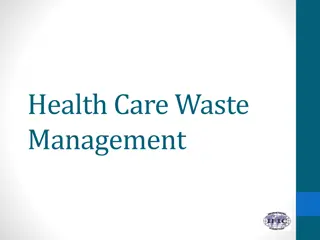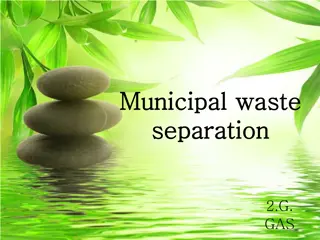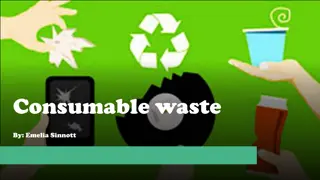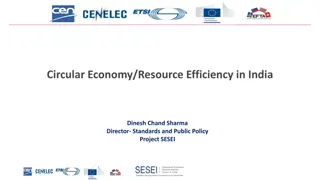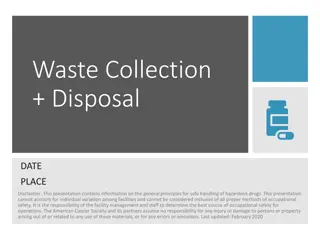WASTE STATISTICS IN AZERBAIJAN
Official statistics and legal framework governing waste management in Azerbaijan, including laws on environmental protection, industrial and household wastes, and hazardous waste management. The country has established a unified classification system to harmonize with European standards for waste classification and reporting.
Download Presentation

Please find below an Image/Link to download the presentation.
The content on the website is provided AS IS for your information and personal use only. It may not be sold, licensed, or shared on other websites without obtaining consent from the author.If you encounter any issues during the download, it is possible that the publisher has removed the file from their server.
You are allowed to download the files provided on this website for personal or commercial use, subject to the condition that they are used lawfully. All files are the property of their respective owners.
The content on the website is provided AS IS for your information and personal use only. It may not be sold, licensed, or shared on other websites without obtaining consent from the author.
E N D
Presentation Transcript
STATE STATISTICAL COMMITTEE REPUBLIC OF AZERBAIJAN WASTE STATISTICS IN AZERBAIJAN Rena Lazimova Environment, Forestry and Fishery Section Head Waste Statistics Workshop Geneva, 4 November 2013 1
OFFICIAL STATISTICS LEGAL FRAMEWORK Constitution of Azerbaijan, Art. 94; Official Statistics Law (18.02.1994, latest amendments dd. 15.11.2011); Statute of the State Statistical Committee of the Republic of Azerbaijan. Statistical data are collected in accordance with the Statistics Law. The Law enables obtaining information on the processes in economic and social areas of the country. The Law also sets fundamental principles of data collection, storage, analysis, compilation, presentation and publication. Compliance with the Law is mandatory for all government authorities, entities, organizations and units irrespective of ownership, subordination and locations as well as for individuals. 2
Azerbaijan has set up a unified classification system which is harmonized with relevant European classifications. 1.Classification of Economic Activities - NACE rev.2; 2.Classification of Products - CPA 2008; 3.List of Industrial Products - PRODKOM 2009; 4.Classification of Economic Sectors; 5.Statistical Waste Classification LIST of Wastes, EWC-Stat/variant 3; 6.Classification of Environmental Activities and Expenditures 2011; 7.Classification of Administrative Territorial Division. In 2011, Azerbaijan approved a system of environmental indicators which is based on official statistical reporting templates. 3
LEGAL FRAMEWORK FOR WASTE 1. Law on Environmental Protection, dd. 8 June 1999, No. 678-1Q; 2. Law on Environmental Security, dd. 8 June 1999, No. 677-1Q; 3. Law on Industrial and Household Wastes, dd. 30 June 1998, No. 514-1Q; 4. Resolution of the Cabinet of the Azerbaijan Republic on the Rules of Temporary Storage, Movements and Disposal of Municipal Wastes in Cities and Other Localities in Accordance with Sanitary, Hygienic and Ecological Standards, dd. 21 April 2005, No. 74; 5. Resolution of the Cabinet of the Azerbaijan Republic on the Rules of Inventory of Wastes Generated in Industry, dd. 28 January 2008, No. 13; 6. Resolution of the Cabinet of the Azerbaijan Republic on Rules of Setting Fees for Waste Collection, Landfilling, Recovery and Disposal, dd. 12 August 2008, No. 185; 4
7. Resolution of the Cabinet of the Azerbaijan Republic on the Rules of Certification of Hazardous Wastes, dd. 31 March 2003, No. 41; 8. Resolution of the Cabinet of the Azerbaijan Republic on the Government Strategy for Hazardous Waste Management in the Azerbaijan Republic, dd. 25 August 2004, No. 117; 9. Basel Convention on the Control of Transboundary Movements of Hazardous Wastes and Their Disposal, which Azerbaijan joined in 2001; 10. Resolution of the Cabinet of the Azerbaijan Republic on Rules of Transboundary Movements of Hazardous Wastes, dd. 25 July 2008, No. 167; 11.Resolution of the Cabinet of the Azerbaijan Republic on the Requirements to Medical Waste Management, dd. 28 December 2007, No. 213. 5
2006-2010 Action Plan to Improve Environmental Situation in Azerbaijan (2005) Azerbaijan attaches importance to environmental issues and therefore has adopted a 5-year Action Plan to address the issue which has become a landmark in the area. The Action Plan includes activities to address issues related to the clean-up of the Baku Bay, Bibi-Aibat zone, area of the International Airport and Absheron Peninsula from oil puddles as well as oil contaminated land and areas under local water containing considerable process waste. One of major projects was the construction and start-up of a plant in Baku to incinerate solid municipal waste. The project was implemented at the level of the European standards. 6
Azerbaijan 2020: Outlook for the Future (2012) Concept Paper One of fundamental objectives of the concept paper is to achieve environmentally sustainable social and economic development. Necessary activities will be performed to promote waste recycling, processing and disposal and to implement non-waste and low-waste technologies with a view to save raw materials, to use natural resources in a sound way and to protect the environment. Advanced waste management methods will be applied and entities will be established for industrial and household waste recycling. 7
WASTE REPORTING SYSTEM Statistical reporting forms: 1. Form 14-Secondary raw materials (wastes), Statement of generation and use of secondary raw materials (wastes); 2. Form 2-TP (wastes), Generation and movements of hazardous wastes; 3. Form 1-Medical wastes, Generation and movements of medical wastes. 8
New reporting form 2-TP(wastes): Generation and movements of hazardous wastes Balance at the end of a reference year (line 1+2+3-5-6-9) Given to third parties Placed on site (at the place of generation) Received form third parties Waste disposal H-code by characteristics of hazardous waste Balance at the beginning of a reference year Used on site (at the place of generation) of which for: reclamation, direct re-use or alternative uses possibility of resource recovery, recycling, Generated in a reference year recovery, recycling reclamation, direct re- Operations which may lead to resource Name of hazardous waste Of which from other countries (import) Operations which do not lead to the of which to other countries (export) Neutralized (disposed) Line code use or alternative uses Total Total Total landfilling storage B C 1 2 3 4 5 6 7 8 9 10 11 12 13 14 Amount of hazardous waste Total of which by characteristics of hazardous waste: X 010 020 030 9
Statistical form 1, Generation and movement of medical wastes kg Wastes received from third parties for neutralization (disposal) 5 Balance at the end of a reference year (Column 7 = Columns 1+2- 3-4+5) 7 Waste Code in the Basel Conventi on Balance at the beginning of a reference year Wastes disposed for neutralization (removal) to third parties Wastes neutralized on site (removed) Generation in a reference year Wastes disposed on site Line code Hazard level A B C 1 2 3 4 6 Total medical wastes, all classes, (sum of rows 2-5) 01 including: Class A Total non-hazardous medical wastes 02 Class B Total hazardous medical wastes 03 Class Total especially hazardous wastes, etc. 04 Class Total wastes equated to industrial wastes 05 10
Time series of waste-related indicators for 19902010, Table 1. Waste generation: the Republic of Azerbaijan Waste generation by source Unit 1990 1995 2000 2001 2002 2003 2004 2005 2006 2007 2008 2009 2010 2011 2012 Agriculture, forestry and fishing (ISIC 01-03) 1000 t/ year ... 6,4 6,2 10,4 13,1 19,4 20,9 15,8 8,2 6,4 2,7 2,7 2,6 2,0 7,0 5 Mining and quarrying (ISIC 05-09) 1000 t/ year 1000 t/ year ... 24,2 10,0 13,8 27,9 39,2 52,7 22,4 15,8 33,3 32,6 153,5 246,6 409,3 542,8 6 Manufacturing (ISIC 10 - 33) ... 242,9 115,5 145,3 240,3 429,4 573,1 741,7 486,0 393,4 463,2 325,4 391,0 532,3 868,6 7 Electricity, gas, steam and air conditioning supply (ISIC 35) 1000 t/ year 1000 t/ year 1000 t/ year ... 0,3 0,3 0,7 0,5 0,8 33,3 26,0 20,3 2,4 3,6 3,2 1,6 4,5 11,2 8 ... 0,0 0,0 0,0 0,0 0,8 0,003 9,2 0,1 0,4 0,2 0,0 0,6 0,6 0,7 9 Construction (ISIC 41 - 43) ... 0,3 0,1 0,1 0,1 0,1 0,1 3,8 337,2 316,2 284,1 196,5 5,4 59,8 18,1 Other economic activities excluding ISIC 38 10 1000 m ... ... 4600,0 5282,4 7724,2 7868,8 7431,7 7304,5 6554,6 6797,7 6160,0 6677,7 6705,3 7418,7 6862,9 3/year Municipal waste 11 1000 t/ year 1000 t/ year 1000 t/ year 1000 t/ year Of which ( of 11 ) hazardous waste 12 Of which (of 11 ) from households 13 274,1 132,1 170,3 281,9 489,7 680,103 818,9 867,6 752,1 786,4 681,31 647,8 1008,5 1448,4 14 Total waste generation (5 + 6 + 7 + 8 + 9 + 10 +11) 27,0 26,6 16,4 9,8 26,9 11,2 12,8 29,5 10,4 24,3 131,8 140,0 185,4 297,0 Of which (of 14) hazardous waste 15 16 7,2 7,7 8,1 8,2 8,3 8,3 8,4 8,6 8,7 8,8 8,9 9,0 9,1 9,2 9,4 Million Population of the country 17 ... ... 567,9 644,2 930,6 948,0 884,7 849,4 753,4 772,5 692,1 742,0 736,8 806,4 730,1 Municipal waste per capita (11/17) 18 kg/per capita Million USD 5352,7 7473,0 7979,3 8369,6 9126,2 9964,5 13238,9 18834,0 24588,5 28437,1 31794,5 33223,7 33161,1 33107,2 19 GDP constant prices 2005 kg/1000 USD Industrial (manufacturing) waste per unit GDP (7/19) 45,4 15,5 18,2 28,7 47,1 57,5 56,0 25,8 16,0 16,3 10,2 11,8 16,1 26,2 20 kg/1000 USD 21 Total waste per unit of GDP (14/19) 51,2 17,7 21,3 33,7 53,7 68,3 61,9 46,1 30,6 27,7 21,4 19,5 30,4 43,7 kg/1000 USD 5,0 3,6 2,1 1,2 2,9 1,1 1,0 1,6 0,4 0,9 4,1 4,2 5,6 9,0 Hazardous waste per unit of GDP (15/19) 22 11
WASTE STATISTICS OUTLOOK Household wastes statistics WASTE DATA COLLECTION AND PROCESSING ISSUES The national environmental legislation requires waste generators to prepare statistical reports for wastes. However, not all waste generators prepare such reports, though non-compliance with the law entails in administrative fines. The collection of data from private businesses and institutions is also complicated. There is no comprehensive reporting for all types of wastes. This is mainly because waste generators are not familiar with laws and bylaws. Even if there is some waste recording, mainly it covers only some types of wastes whereas other wastes are not recorded. For instance, production plants keep records of major production waste, whereas such wastes as used cartridges, fluorescent lamps, accumulators, waste oil, etc. remain unrecorded. There is no consistent system for waste recording. Records are maintained either in cubic meters, or in tones, or in kilograms or in pieces. 12
OFFICIAL STATISTICAL PUBLICATIONS OF THE AZERI STATE STATISTICAL COMMITTEE ON WASTE STATISTICS Annual publications: Statistical bulletins Hazardous Wastes in Azerbaijan Republic; Recycling. Statistics digests Environment, Forestry, Game Management and Fishery in Azerbaijan; Statistical Indicators of Azerbaijan; Azerbaijan-Russia (2013). Alert service Industrial and household wastes; Generation and movements of hazardous wastes ALL STATISTICS ARE PUBLICLY AVAILABLE www.stat.gov.az 13
Thank you! renal@azstat.org 14
